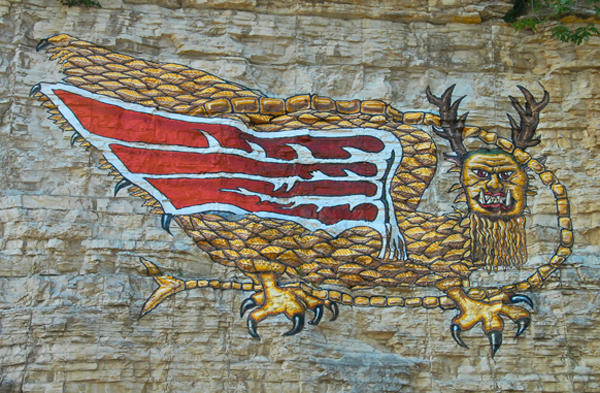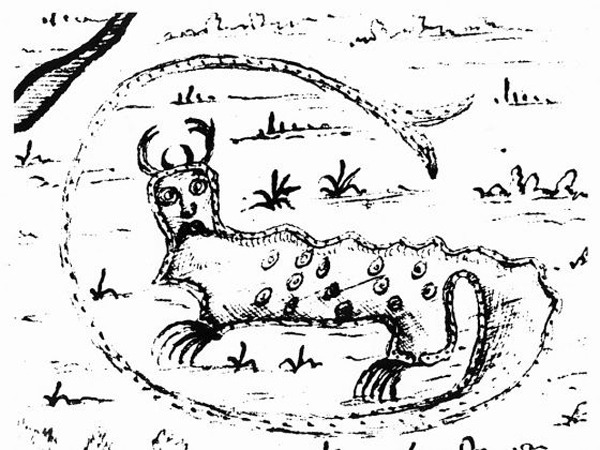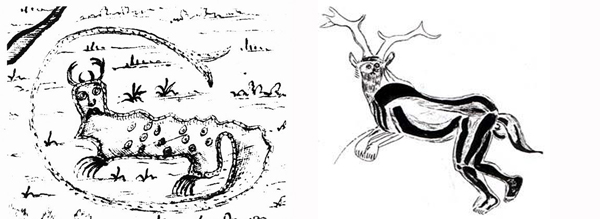I was raised on the West Coast and had only been “east” once before meeting my wife. In 1972 we flew east to meet my future in-laws who lived in the tiny village of Piasa, Illinois. A couple of days later they took me to see the famous painting along the Great River Road near Alton, Illinois. My wife had graduated from Piasa Southwestern High School whose mascot was fittingly the Piasa Bird. So I was quickly indoctrinated with the local lore and history of this famous character.
The painting as it looks today along the bluffs of the Mississippi.
But what about the history of the monster?
In 1673, Â Pere Marquette and Louis Joliet, while traveling down the river spotted the painting of the monsters along the bluffs. Marquette wrote down this description:
“While skirting some rocks, which by their height and length inspired awe, we saw upon one of them two painted monsters which at first made us afraid, and upon which the boldest savages dare not long rest their eyes. They are as large as a calf; they have horns on their heads like those of deer, a horrible look, red eyes, a beard like a tiger’s, a face somewhat like a man’s, a body covered with scales, and so long a tail that it winds all around the body, passing above the head and going back between the legs, ending in a fish’s tail. Green, red, and black are the three colors composing the picture. Moreover, these two monsters are so well painted that we cannot believe that any savage is their author; for good painters in France would find it difficult to paint so well, and besides, they are so high up on the rock that it is difficult to reach that place conveniently to paint them. Here is approximately the shape of these monsters, as we have faithfully copied it.”
Drawing on 1678 map by Lean Baptiste Louis Franqueli
Quoting from the Alton Telegraph Newspaper
This wingless Piasa was included on a 1678 map, “Discovery of the Illinois country,” drawn by French cartographer Lean Baptiste Louis Franquelin of Quebec. The original map is in a French government museum collection. Photo courtesy of Service Historique de le Marine. A drawing of a Piasa Bird was described by Pere Jacques Marquette on his missionary journey down the Mississippi in 1673. Art from Telegraph archives.
So it can easily be seen by Marquette’s description and the drawing that the original monster did not have bird wings.
What about the name Piasa? Â From Webster’s Dictionary we read:
The name “Piasa”, pronounced in English /ˈpajəˌsÉ‘Ë/ or “pie-uh-saw”, is from the Miami-Illinois word páyiihsa (cf. Anishinaabe: apa’iins(ag), “little people(s)”),[1] the name for a type of small supernatural dwarves said to attack travelers. The connection between this Miami-Illinois word and the “Piasa” illustration is confirmed by such early French transcriptions as “paillissa”, found on Nicolas de Finiel’s map of 1798. (See Costa 2005: 297). Etymologies which claim the word “Piasa” means “the bird that devours men” or “bird of the evil spirit” are impossible, and are not rooted in the Illinois language.
Could these “little people(s)” or  “small supernatural dwarves” actually be juvenile sasquatch?
What wild-man / bigfoot / sasquatch features does the monster exhibit? According to Marquette – “a horrible look, red eyes, a beard like a tiger’s, a face somewhat like a man’s.”  Do not all of these features appear to be possibly sasquatch features? Many witnesses report sasquatch as having eyes that glow red, being hairy with beards, facial features being man-like. And in recent years reports have come in with sightings of sasquatch running as quadrupeds.
In the book Santa Claus, Last of the Wild Men, the author Phyllis Siefker traces the origins of wild man worship back at least four thousand years. Â Paintings from the famous “The Sorcerer” at the cave of Les Trois Freres in France clearing show a shaman dressed in animal skins.
The Piasa “monster” on the left and the “Sorcerer” from France on the right.
But, were Wildman or Sasquatch found in this part of the country? Both modern sighting reports and audio recordings would seem to indicate that is still the case.


